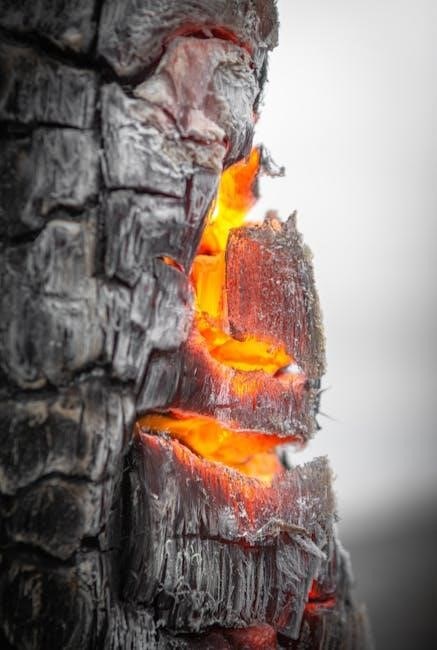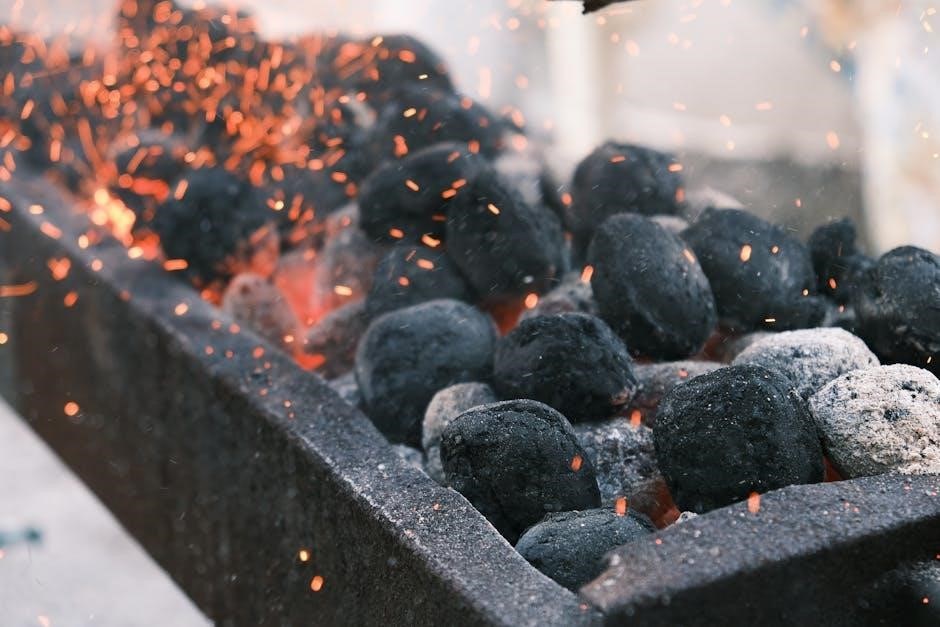FireAngel carbon monoxide detectors, like the CO-9B model, are designed to detect deadly CO levels, offering early warnings with LED indicators and an 85dB alarm for safety.
Overview of FireAngel CO Detectors
FireAngel CO detectors, such as the CO-9B and CO-808S models, are compact, lightweight devices designed to detect carbon monoxide levels. They feature LED indicators for power and alarm status, ensuring easy monitoring. These detectors provide an 85dB alarm for emergency alerts and are certified to European safety standards EN 50291-1:2010 and EN 50291-2:2010. With a focus on reliability, FireAngel detectors offer self-check functions, resistance to false alarms, and a 7-year warranty, ensuring long-term protection for homes and families.
Importance of Carbon Monoxide Detection
Carbon monoxide (CO) is a silent killer, odorless and invisible, making detection critical for safety. FireAngel CO detectors provide early warnings of dangerous CO levels, preventing potential poisoning. CO exposure can lead to severe health issues or fatalities, especially in confined spaces. Proper detection ensures timely action, safeguarding lives and property. Regular monitoring through reliable devices like FireAngel detectors is essential, as CO can emanate from faulty heating systems, water heaters, or fuel-burning appliances, often going unnoticed until it’s too late.

Understanding Carbon Monoxide and Its Dangers
Carbon monoxide is a colorless, odorless gas produced by incomplete fuel combustion. It is highly toxic, causing severe health risks, even death, in high concentrations.
What is Carbon Monoxide?
Carbon monoxide (CO) is a colorless, odorless, and tasteless gas produced by incomplete combustion of fuels like coal, wood, or gasoline. It is highly toxic and can cause severe health issues, including headaches, dizziness, and even death in high concentrations. CO detectors, such as FireAngel devices, are essential for early detection, as the gas is undetectable without specialized equipment.
Health Risks Associated with CO Exposure
Carbon monoxide exposure can lead to severe health issues, including headaches, dizziness, nausea, and confusion. Prolonged exposure may cause brain damage, heart problems, or even death. CO interferes with oxygen delivery in the blood, particularly harming vulnerable groups like children, pregnant women, and those with pre-existing medical conditions. Early detection through devices like FireAngel CO detectors is critical to prevent these life-threatening risks and ensure timely action to safeguard health and safety.
Key Features of FireAngel Carbon Monoxide Detectors
FireAngel CO detectors feature LED indicators, an 85dB alarm, test/reset buttons, and self-check functions. They are compact, portable, and designed for easy installation and maintenance.
Technical Specifications
FireAngel CO detectors, such as the CO-9B and CO-808S, feature LED indicators for power and alarm status. They emit an 85dB alarm at 1 meter, ensuring loud alerts. These devices are lightweight, portable, and designed for easy installation. They comply with EN 50291-1:2010 and EN 50291-2:2010 standards, ensuring reliability. Some models include a 7-year warranty and end-of-life indication. Battery-powered options are available, eliminating the need for an electrician. Regular self-check functions ensure optimal performance and safety.
Benefits of FireAngel CO Detectors
FireAngel CO detectors offer reliable protection with early warning systems for dangerous CO levels. Their 85dB alarms and LED indicators ensure clear alerts. Lightweight and portable, they are ideal for travel and easy installation. Compliance with EN 50291 standards guarantees safety and performance. A 7-year warranty and end-of-life indication provide long-term reliability. Battery-powered models eliminate the need for complex wiring, making them user-friendly and accessible for all households seeking efficient carbon monoxide detection.
Installation Instructions
Install your FireAngel CO detector 5 feet from fuel-burning sources, near sleeping areas, and high on walls. Avoid extreme temperatures and humidity. Use the mounting bracket, secure it with screws, and ensure alignment. Test the detector by pressing the test button to check the 85dB alarm and LED indicators. Follow the step-by-step guide in the manual for proper setup and function.
Choosing the Right Location for Your Detector
Place your FireAngel CO detector at least 5 feet away from fuel-burning appliances and outside sleeping areas for optimal detection. Avoid locations near windows, doors, or areas with high humidity or extreme temperatures. Install detectors high on walls or on ceilings, ensuring they are not obscured by furniture. Follow local regulations and manufacturer guidelines for placement. Avoid areas with drafts to prevent false alarms. Proper placement ensures accurate detection and reliable performance of your FireAngel CO detector.
Step-by-Step Installation Guide
Begin by unpacking your FireAngel CO detector and reading the manual. Choose a location at least 5 feet from fuel-burning appliances. Mount the detector on a wall or ceiling using the provided screws or adhesive strip. Ensure it is level and secure. Press the test button to activate the alarm and verify it works. If battery-powered, insert the batteries correctly. For hardwired models, connect to your home’s electrical system. Double-check all connections and test the alarm again. Ensure proper installation for reliable performance and safety.
Testing and Maintenance
Test your FireAngel CO detector weekly by pressing the test button to ensure the alarm sounds. Clean with a soft brush and check battery levels regularly. Replace batteries or detectors as needed to maintain reliability and safety.
How to Test Your CO Detector
To test your FireAngel CO detector, press the test button weekly to ensure the alarm sounds. Check the LED indicators for proper function. Clean the detector with a soft brush to remove dust. Replace batteries or the detector as needed when low battery signals or end-of-life indicators appear. Regular testing ensures your detector operates reliably, providing crucial safety protection against carbon monoxide threats.
Regular Maintenance Tips
Regularly vacuum the detector to remove dust and debris. Ensure no obstructions block the sensor. Replace batteries annually or as indicated by low-battery signals. Check expiration dates and replace detectors after 7-10 years. Avoid exposing detectors to harsh chemicals or extreme temperatures. Follow manufacturer guidelines for maintenance to ensure optimal performance and reliability of your FireAngel CO detector, safeguarding your home and family from carbon monoxide risks.

Troubleshooting Common Issues
Check for low batteries, sensor blockages, or high humidity causing false alarms. Ensure proper placement away from steam sources. Refer to manual for reset instructions if beeping persists.
Why Your CO Detector Might Be Beeping
Your FireAngel CO detector may beep due to low battery, high carbon monoxide levels, or sensor issues. Continuous beeping often signals a fault, while intermittent beeps may indicate low power or high humidity. Check for blockages or damage to the sensor. Ensure proper placement away from steam sources, as moisture can trigger false alarms. Refer to the user manual for troubleshooting steps or reset instructions if the issue persists.
Resolving Common Malfunctions
To address issues with your FireAngel CO detector, first check for low battery or power interruptions. Ensure the device is clean and free from dust. If the alarm beeps erratically, press the test/reset button to reset it. For persistent problems, replace the battery or the unit if it’s near the end of its lifespan. Ensure proper installation and avoid placing detectors near steam sources, as moisture can trigger false alarms. Regularly test the device to ensure it’s functioning correctly.
Safety Tips and Best Practices
Ensure your FireAngel CO detector is installed in well-ventilated areas, avoid high-moisture zones, and test it weekly to maintain optimal performance and safety.
Preventing False Alarms
To minimize false alarms, install your FireAngel CO detector away from kitchens, bathrooms, and areas with high humidity or direct sunlight. Avoid placing it near fuel-burning appliances or strong chemicals. Regularly clean the detector to remove dust or debris. Ensure proper ventilation in the room and avoid covering the sensor. Test your detector weekly to confirm it’s functioning correctly. Replace batteries promptly when low-battery signals occur to prevent unnecessary alerts.
What to Do in Case of a CO Alarm
If your FireAngel CO detector sounds an alarm, stay calm but act quickly. Immediately evacuate all household members from the building, including pets. Call your local emergency services or fire department from a safe location. Do not re-enter the premises until authorities confirm it is safe. Check for symptoms of CO poisoning, such as headaches or dizziness, and seek medical attention if necessary. Once cleared, ensure the detector is reset and functioning properly.

Warranty and Certification Information
FireAngel CO detectors are backed by a 7-year warranty and certified to European standards EN 50291-1:2010 and EN 50291-2:2010, ensuring reliability and compliance.
FireAngel Warranty Details
FireAngel carbon monoxide detectors come with a 7-year warranty, covering manufacturing defects. The warranty period begins upon purchase and requires proof of purchase. It does not cover damage from misuse or tampering. FireAngel ensures reliability and compliance with safety standards, providing peace of mind for users. The warranty underscores FireAngel’s commitment to quality and customer satisfaction, ensuring your detector remains functional and reliable for years.
Compliance with Safety Standards
FireAngel carbon monoxide detectors meet European safety standards EN 50291-1:2010 and EN 50291-2:2010, ensuring reliable detection and alarm performance. These certifications guarantee that FireAngel devices are rigorously tested for accuracy and responsiveness. Compliance with these standards means users can trust their FireAngel detectors to provide consistent and dependable protection against carbon monoxide threats, adhering to the highest industry benchmarks for safety and effectiveness in home environments.
Comparison with Other CO Detectors
FireAngel CO detectors stand out with their 7-year warranty and portability, offering a competitive edge over other brands in terms of reliability and convenience for users.
FireAngel vs. Other Brands
FireAngel CO detectors excel with their 7-year warranty, portability, and compliance with European standards. Unlike some competitors, they offer a battery-powered option, eliminating the need for an electrician. Their self-check feature ensures reliability, and the loud 85dB alarm provides clear alerts. FireAngel detectors are also resistant to false alarms from common household contaminants, making them a durable choice compared to other brands.
Unique Selling Points of FireAngel Detectors
FireAngel detectors stand out with their 7-year warranty and portability, making them ideal for travel. They feature an 85dB alarm, test/reset button, and end-of-life indication. Battery-powered models eliminate the need for an electrician, while compliance with European standards ensures reliability. Their resistance to false alarms from household contaminants and continuous monitoring capability make them a top choice for safety and convenience.

Frequently Asked Questions
Common questions include why detectors beep continuously, indicating faults, and how to test or reset alarms. Users also ask about installation and battery replacement.
Common Questions About FireAngel CO Detectors
Users often ask why their FireAngel CO detector beeps continuously, which usually indicates a fault or low battery. Another common question is how to test the device, done by pressing the test button weekly. Many inquire about the detector’s lifespan, typically 10 years, and whether it detects other gases, which it does not. Additionally, users want to know how to silence false alarms and understand LED indicator meanings, which are explained in the manual.
Expert Answers to User Queries
Experts recommend testing FireAngel CO detectors weekly by pressing the test button to ensure functionality. If the alarm beeps continuously, check for low battery or fault conditions. The detector should be replaced after 10 years of use. Ensure installation in rooms with temperatures between -10°C and 40°C for optimal performance. Note that FireAngel detectors are designed to detect only carbon monoxide, not other gases, and should be used alongside smoke alarms for comprehensive safety.
FireAngel carbon monoxide detectors provide reliable protection with early warnings, ensuring home safety through continuous monitoring and clear alerts, while proper maintenance maximizes their effectiveness.
Final Thoughts on FireAngel CO Detectors
FireAngel CO detectors are reliable and effective, offering advanced features like LED indicators and loud alarms to ensure safety. Proper installation and maintenance, as per the manual, are crucial for optimal performance. By following guidelines, users can maximize protection against carbon monoxide threats, making FireAngel detectors a vital addition to any home safety system.
Importance of Proper Usage and Maintenance
Proper usage and maintenance of FireAngel CO detectors are crucial for ensuring reliable protection. Regular testing, battery checks, and cleaning prevent false alarms and malfunctions. Replace detectors at the end of their lifespan, typically 7 years, to maintain accuracy. Adhering to the manual’s guidelines ensures optimal performance, safeguarding against carbon monoxide threats. Neglecting maintenance can lead to device failure, putting lives at risk. Always follow FireAngel’s instructions to guarantee your detector operates effectively and provides continuous safety.
